This post marks the return of an old format: Photo of the Day.
Recently I was in an apartment in one of those new buildings on Great North Road Grey Lynn at rush hour. Perfect day, the view was stunning, so naturally I whipped out my phone:
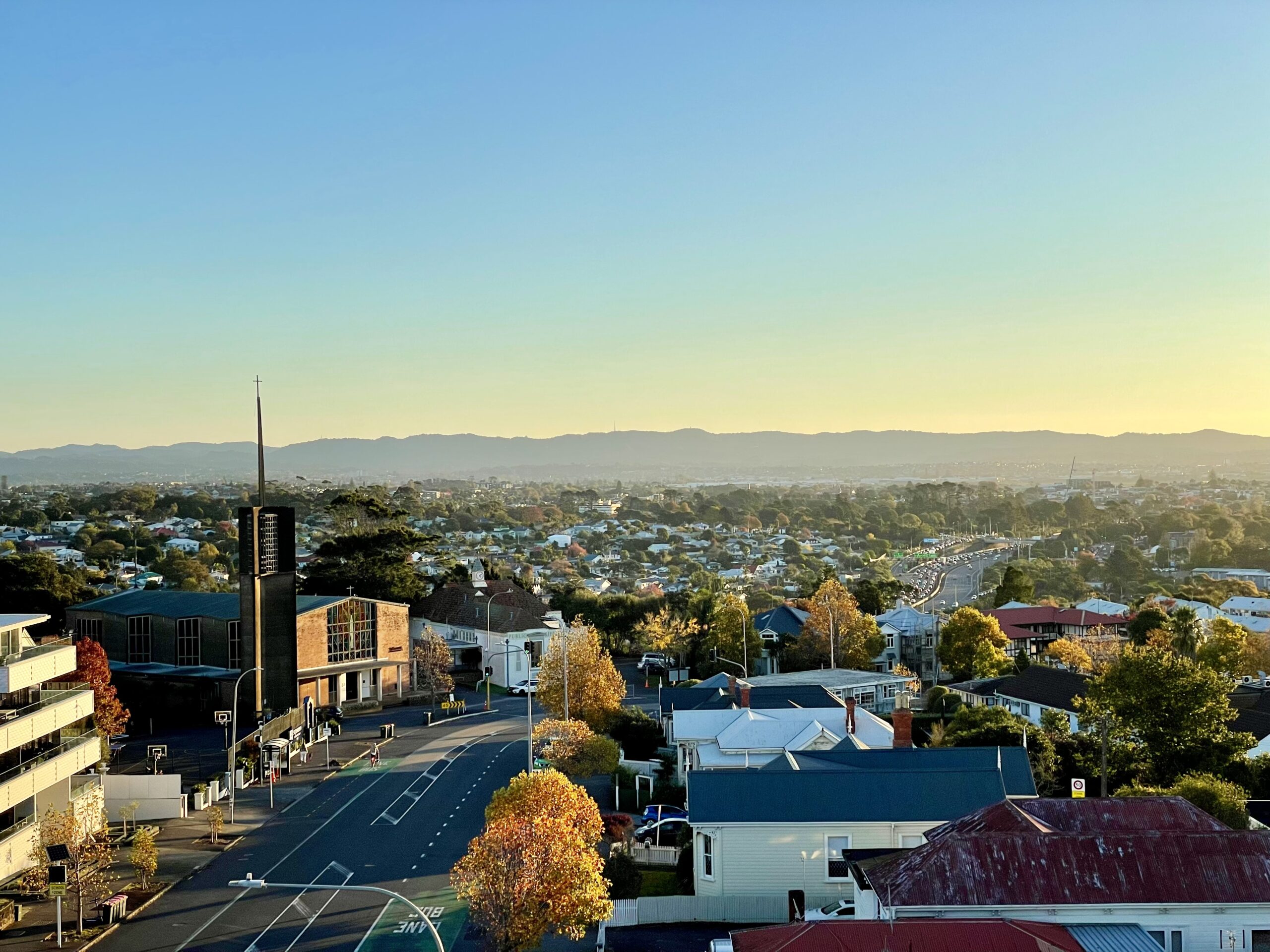
Turns out I caught a fascinating moment; compare these two details:
a lone traveller heading west on GNR, and, in the distance:
State Highway 16 doing its afternoon rush thing.
This contrast opens up a whole lot of interesting thoughts about transport and land use, especially as both routes are due some significant upgrades.
First up I have to say this is great, we build urban motorways in part to ‘relieve’ local roads. This usually doesn’t happen of course, traffic is additive in a growing city. But in some cases it does, and this is the best ever example of it I have seen. Here, the old route north (GNR) has indeed been successfully bypassed. Hooray!
Which means it’s time to:
- Change the planning regulations along GNR to unlock higher value land-use now it is no longer a traffic sewer with suppressed value.
- Repurpose the old route to suit its new role of local access and prioritising non-motorway modes: transit and active; to become the tree-line boulevard it so should be.
- And also: fix the motorway, which is failing at its job, as we all predicted (eg here from 2010, or here from 2017) because it lacks a relieving rapid transit alternative.
The first of these has happened to a degree with the Unitary Plan, hence the six-story apartment blocks.
The second has been imminent from AT for years, was funded by the board in June last year, and here’s some history of this much delayed project.
And the third has had a ‘start-up’ version; more is in design – again, led by Waka Kotahi – and listed in the new government’s draft GPS, so there’s hope for something one day.
For here is the Infrastructure Commission using data from SH16 with the obvious:
So perhaps sometime this decade we may have both an apartment- and tree-lined Great North Road, busy with walkers, local business, people riding safely, and many prioritised buses, while off in the distance is a productive motorway, with general traffic moving, because an efficient rapid transit service is there too, as there always should have been, taking so much of the task of moving outer burb people. And all of it both more visible and quieter through the clearer air… ahhh.
Meantime:
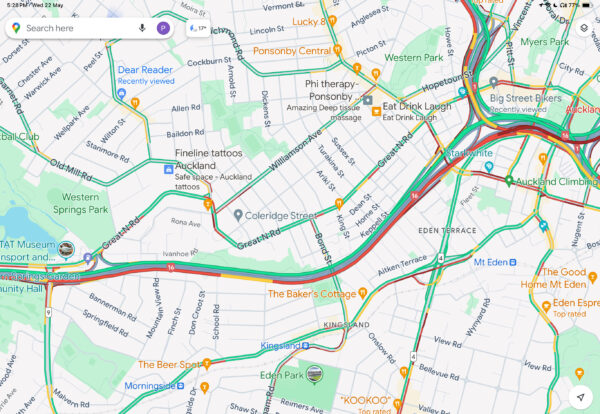

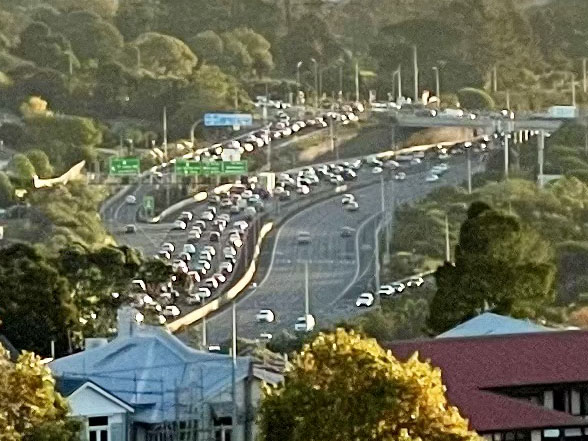
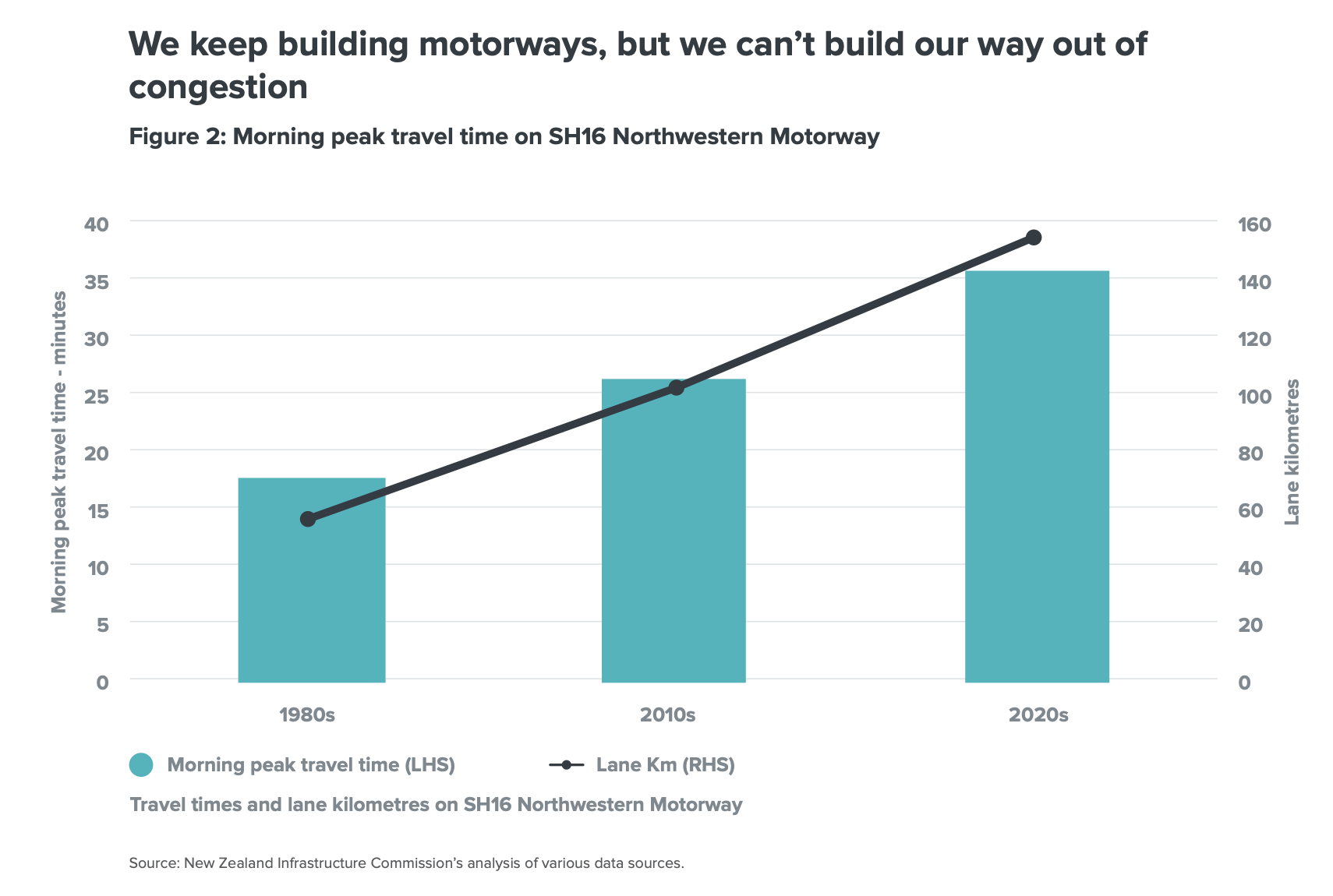
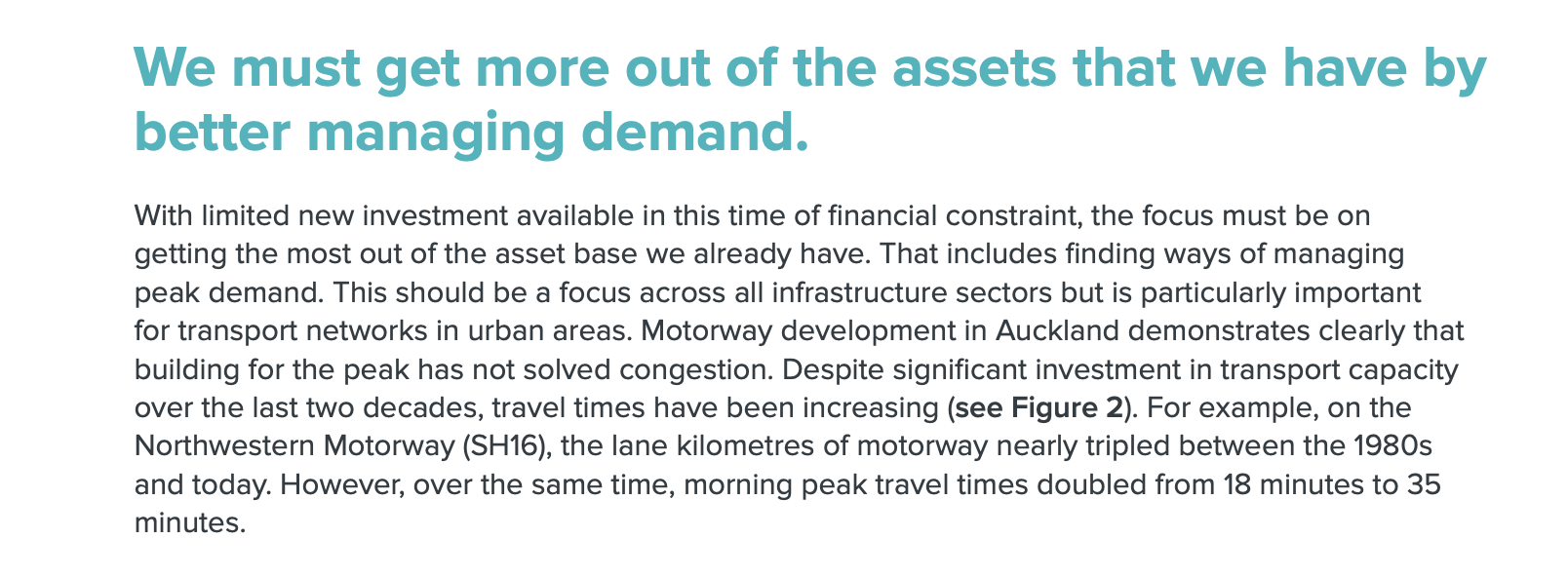

 Processing...
Processing...
This is not normal! I live on GNR closer to MOTAT and the traffic during rush hours is horrendous! If I am driving home during evening rush hour (I try not to) I know not to drive on GNR from the north. There is normally a traffic jam heading down the road that will give me at least 5 minutes longer to navigate. There is virtually always a jam from the Bullock Track to St Lukes Rd.
This was a very unusual time!
Yes, all around the St Lukes intersection is terrible, at most times. That is a function of the motorway ramps, you can see the off ramp queue in the image above. The lower traffic condition is only on the Grey Lynn section.
This still very unusual I would say. Most times (not only rush hours) I have to wait minutes to get out of my driveway.
Sure there are queues to enter the motorway. But the traffic heading to the ramps is using GNR and other main thoroughfares to get there. St Lukes Rd is also jammed during rush hours.
You can possibly see that congestion outside your place on the Google Live Traffic map above. Some of it will be due to the traffic that rat runs through Herne Bay and Westmere, using a number of options to rejoin the motorway (or head elsewhere), including using the St Lukes interchange, clogging up GNR locally.
It’s probably that bottle neck which is preventing more people from using GNR up in Grey Lynn; they might as well get into the motorway
AFC modelling shows twice as much traffic on Williamson Ave (which is why it needed THAT raised crossing) and also on Bond Street. Dare we suggest that the westbound bus lane on GNR might not be needed in the future, making room for those trees on the south side from Bond Street to Arch Hill?
Twice as much as compared to what?
I love that graph (Fig 2). Wish more media would publish this sort of thing so that the vast majority understand the need to increase public transport.
Currently, AT are taking raised pedestrian crossings out of some streetscape designs for arterials, and reducing the effectiveness of others by using shallow slopes. I’ve seen the rationale and it neither follows the evidence nor complies with the advice from the safety review, which told AT that putting raised crossings on arterials is one of the most important things to do.
Hopefully the traffic situation on GNR means it wasn’t difficult for staff to retain all the raised crossings in this design, without compromising their slopes. There’s not even a (flawed) economic excuse for doing so.
Raised crossings, continuous footways, side road entry treatments et al can transform the street environment to include children, old people, mobility-impaired people and many others.
Vivian Naylor (a recognised disability expert) posted a whole series of quotes on GA on 14 May. https://www.greaterauckland.org.nz/2024/05/13/will-nz-heralds-poor-journalism-cost-lives/#comments
This quote encapsulates the benefits that raised crossings can bring: “When I am lucky enough to be crossing the road at a raised platform crossing, it ultimately removes my disability!”
It takes real arrogance to reject this proven design approach on the basis that it is “woke”, “gold-plated” or “nice-to-have”. AT needs to step out of stupid culture wars and place much more emphasis on objective evidence.
So who AT at is insisting that raised tables are taken out of designs against evidence and safety reviews. In the business world that would be a disciplinary discussion at the very least. What is so different about AT that safety reviews can be ignored??
Who indeed? Is there anyone reading this who works at AT? Care to shed some light on this conundrum?
Agree. Is there a legal framework to challenge this? We don’t accept making things less safe or tolerate workplace injury or death in the name of profits in our industries anymore. How are we still so blind to it in our public space?
Lol, oil trader’s trump card is ‘cars run over people *and* are toxic’.
Checkmate liberals.
could just use modern Nox / emissions standards with real world driving tests (which include speed bumps and traffic) so manufacturers have to build less polluting engines.
I was at the Auckland Transport Board Meeting when they approved the GNR redesign, pending dollars invested.
I have often walked this route, and even for a forty plus year old adult man, it is scary, frightening, and life threatening at every intersection and multiple driveways.
I heard the Principal of Grey Lynn Primary School give his views at the AT meeting, and every person should have been convinced, as he was considerate of the safety for our most vulnerable citizens.
It is a shame that the Auckland Council versus Auckland Transport versus Kiwirail versus Waka Kotahi seems to still be the status quo. If we could actually He Waka Kotahi, all get in the same boat (make sure it is a train with tracks)…then we could all move in a positive direction, together!!!
And build more apartments, naturally.
Imagine making that call:
“Yes this well-developed design will provide safety for our youngest citizens and reflects proven safety techiques and is used elsewhere in Auckland…but somebody somewhere might object to it for some reason so let’s spend more money making the design worse:
Perhaps we can manage demand better by users to pay a small share of the user costs of the highway. Some might call it a congestion charge, some time of use. But whatever you call it, it cannot just be provided for free. Until we do, there is no point hammering at the table for addressing an infrastructure deficit until we get a sense of the demand for things after its managed better. Of course this is not to say we shouldn’t have good ideas (benefits outweigh the costs) in hand to be ready to go once we do…
First lets focus first on charging that cyclist the true cost of their barely used cycleway perhaps by adding RUCs for cyclists. I think this image shows you exactly where the demand is.
We need to get rid of that road too. Only one car user?
Pedestrianise the lot.
Exactly.
Well actually that road with the cyclist in it shows no cars apart from parked ones.
you mean the demand induced by decades of petrol-huffing lead-addled suburban sprawl that purposely made walking and cycling inconvenient, difficult and unpleasant?
and if you’re talking ‘fair share’, how about petrol subsidies? the billions in social and healthcare costs of air pollution. the billions in annual social cost of road crashes. the billions in lost productivity from traffic jams. the multibillions NACT want to waste on motorways that aren’t needed?
fyi, studies have been done, and the “true cost” of bike infrastructure is income of up to $20 return for every dollar spent. A BCI far better than any Road of National Party Significance, which last decade barely return a few cents for each dollar spent on them.
Admin, can we delete and ban this and what seems like the same troll person that keep arguing about bike user pays?
“….suggestion that all road users pay their share”.
You mean cyclists and PT users don’t you, UserPays?. Not cars, they deserve subsidies the others don’t, according to you.
tehe. Just getting tired of your repeated assertions that are not really intellectually honest that’s all. Air pollution (as you mention below), for example, is a valid intangible to include in the BCR calculations. I sure would rather walk beside a road getting past by 20 cyclists than 20 cars puffing out exhaust. Check with an expert from the local hospital how many of us have our lives cut short from these sorts of things. Also while there, how healthy on average a regular cyclist is compared to someone sitting in an armchair that moves sucking in the same fumes. The overall benefits of cycling are so great we save the health system a lot of money.
Grant my point is it’s a short term effect. Cars that puff out exhaust will be going away long before everyone starts cycling instead of using cars. Whether New Zealand recognises it or not globally that tipping point has been reached.
And with stop start tech even ICE vehicles aren’t puffing out exhaust gases while not going anywhere.
And KLK we are adding ways of charging all other road users by usage and tolls and congestion charging can be useful tools. But what is sauce for the goose is also good for the gander. There’s no logical reason not to put registration plates on bikes, especially e-bikes which should just be treated as an electric moped or motorcycle depending on capabilities. You can’t just slap an ice engine on a bike and not register it and mount a number plate on it. The same should apply to e-bikes. And if new tolling cameras are introduced the incremental cost of tracking and tolling bikes is minimal.
Relying entirely on electrification to play our fair share of climate action was the go-to solution for years because it required no one in the transport system to have to change what they were doing.
It’s been debunked comprehensively both domestically and internationally. Every advocate for this impractical pathway, when I’ve pushed them about incorporating actual research, display either an almost tribal distrust of research in behavioural and systems change, or admit to not caring about meeting the actual timeframes required.
Using electrification alone fails to solve the multiple problems in our transport problem, leaving the cost of doing so still to be met. This is unethical.
As for people simply trying to get around sustainable on bikes having to pay for roading: they already do, in rates and taxes, far more than any costs they impose. For decades, drivers have not been paying for the infrastructure required to prevent themselves from harming others or forcing others to stop walking or cycling. It’s time to fix that.
Heidi there’s nobody who understands math that believes that cycles will contribute more to CO2e reduction than EVs of all shapes and sizes will. Remember an EV bus or people mover is also an EV.
Out of interest what do you consider to be the remaining ‘multiple problems in our transport problem’ that EVs and ZEVs don’t solve?
I can’t speak for Heidi’s views but I would say: traffic congestion, long and unreliable trips, parking congestion, rate and taxpayer subsidy of roads and parking, traffic injuries and deaths, $700m a year on income compensation for crash victims, use of urban space for road lanes and parking, high resource consumption producing vehicles, high resource consumption producing roads, extensive waste volume from old vehicles, toxic tyre microplastics and brake dust, road noise, paving water runoff contributing to flooding and the urban heat island effect…
I guess some anti-cycling argument, within reason, allows us to counter with some good reasons to encourage more cycling.
Ah yes, let’s conventiently ignore the “intangibles”. I mean we ignore all the negative externalities for cars right?
Its called stacking the deck.